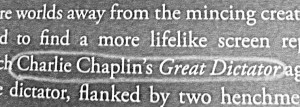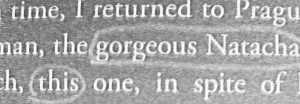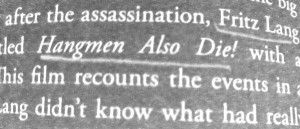January will mark the 80th anniversary of the National Socialists’ seizure of power, and popular interest in the history of the era that followed is as vivid as ever:  34-year-old Laurent Binet’s HHhH, winner of the prestigious Goncourt prize, reconstructs Operation Anthropoid, the skewed but ultimately successful mission of Czech resistance fighters to assassinate Reinhard Heydrich, National Socialist Obergruppenführer, Protector of Bohemia and Moravia, and head of the German secret services. (HHhH is an acronym for “Himmlers Hirn heißt Heydrich,” – Himmler’s brain is Heydrich – which is how Heydrich’s function was described in Nazi circles.)
34-year-old Laurent Binet’s HHhH, winner of the prestigious Goncourt prize, reconstructs Operation Anthropoid, the skewed but ultimately successful mission of Czech resistance fighters to assassinate Reinhard Heydrich, National Socialist Obergruppenführer, Protector of Bohemia and Moravia, and head of the German secret services. (HHhH is an acronym for “Himmlers Hirn heißt Heydrich,” – Himmler’s brain is Heydrich – which is how Heydrich’s function was described in Nazi circles.)
Binet’s rendition is thrilling. The author takes us through each step of the attack, following a series of documents by German officers in Berlin and Prague as well as Czech resistance fighters at home and in London. Yet the novel’s perspective is explicitly contemporary. The chronology documents the author’s research and writing process rather than the dates of the plot, so the eight-hour gun battle in the nave of a church, where the resistance fighters are hiding, bears the dates 27 May 2008 to 18 June 2008. Binet’s historical novel reads in fact like a research diary, a modern blog. As such it is self-reflective, asking for instance whether the author’s “almost unlimited freedom” is not, at times, incompatible with scholarly precision: “inventing a character […] is like fabricating evidence” (ch. 112/192; the English translation, unlike the French original, has no page numbers; here again a wink to modern forms of communication). By pointing out his fictional additions, Binet experiments with the historical novel as a literary genre, which to him seems to have become anachronistic in the age of information.
 As Binet modernizes the historical novel, he popularizes the writing process. Scholarly research is staged like detective work as we know it from film and television: The writer inhabits his characters, follows their traces through various cities, sleeps too little, smokes too much, and suffers from bouts of work-related depression. Binet’s narrator appears more like an action hero than an historian, like a modern James Bond, whose work includes passionate love affairs with two beautiful women.
As Binet modernizes the historical novel, he popularizes the writing process. Scholarly research is staged like detective work as we know it from film and television: The writer inhabits his characters, follows their traces through various cities, sleeps too little, smokes too much, and suffers from bouts of work-related depression. Binet’s narrator appears more like an action hero than an historian, like a modern James Bond, whose work includes passionate love affairs with two beautiful women.
Yet in all his glamor, the historian here tells of more than just how academic work could be imagined by the general public: He testifies to the prestige of art about German National Socialism. Binet names his masters, from Fritz Lang and Bertolt Brecht to Eric Rohmer, Kenneth Branagh, Quentin Tarantino, and Bernd Eichinger. A mong the writers, Binet mentions Éric-Emmanuel Schmitt and Jonathan Littell, who won the 2006 Goncourt prize for Les Bienveillantes – which, Binet remarks derisively, is like “Houllebecq does Nazism” (ch. 204), suggesting that the topic’s renown also attracts ambitious neophytes and other bandwagon jumpers. Binet’s narrator worries obsessively about the reception of HHhH, reflecting, even magnifying the aura of art about the period of National Socialism as if it were today’s unwritten equivalent of history painting in the seventeenth century or the tragedy in Ancient Greece. In light of the film and fiction produced in the past 80 years, perhaps, indeed, it is.
mong the writers, Binet mentions Éric-Emmanuel Schmitt and Jonathan Littell, who won the 2006 Goncourt prize for Les Bienveillantes – which, Binet remarks derisively, is like “Houllebecq does Nazism” (ch. 204), suggesting that the topic’s renown also attracts ambitious neophytes and other bandwagon jumpers. Binet’s narrator worries obsessively about the reception of HHhH, reflecting, even magnifying the aura of art about the period of National Socialism as if it were today’s unwritten equivalent of history painting in the seventeenth century or the tragedy in Ancient Greece. In light of the film and fiction produced in the past 80 years, perhaps, indeed, it is.
Naomi Lubrich, Media